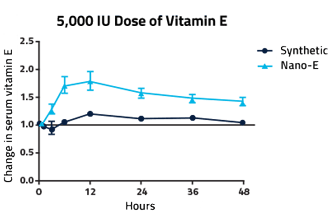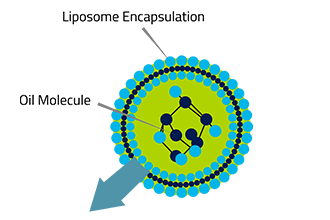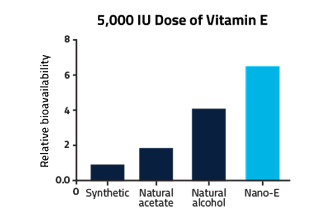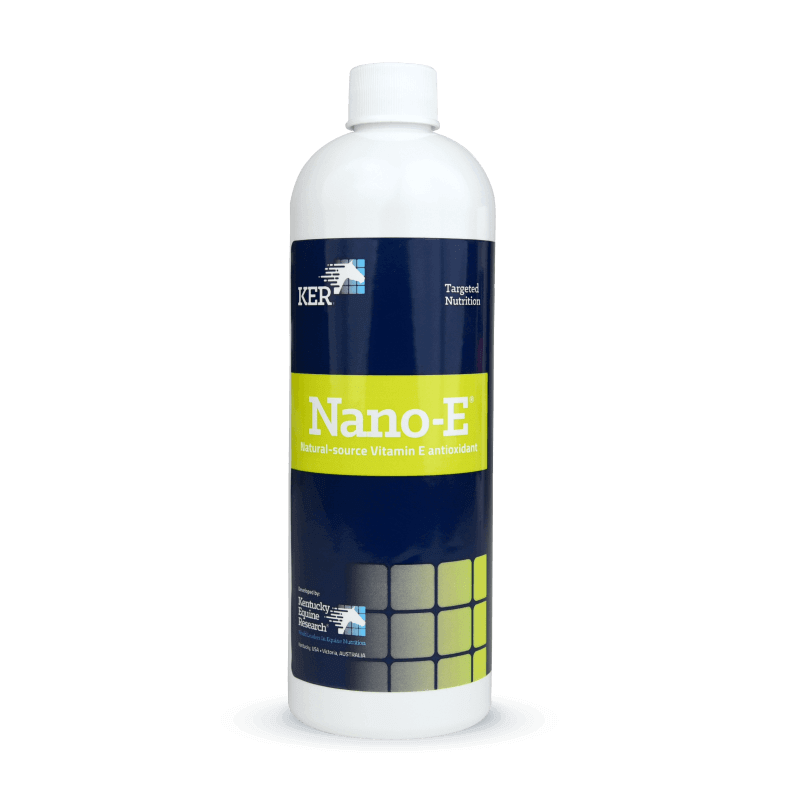Why should I use Nano-E for my horse?
- Vitamin E antioxidant supplement for all types of horses
- Natural-source vitamin E proven more effective than synthetic vitamin E
- Rapidly available so administration may be timed to provide peak antioxidant protection
- Reproductive benefits for breeding stallions, and pregnant and lactating broodmares
Nano-E is recommended for:
- Race and performance horses in intense work
- Horses recovering from illness or injury
- Prior to or following stressful events such as weaning or travel
- Horses with neurological or neuromuscular disease
- Horses in confinement or those not receiving fresh green grass
NANO-E
Vitamin E is first and foremost an antioxidant, an agent
that keeps free radicals from forming and potentially weakening cells and tissues. In addition to its antioxidant responsibilities, vitamin
E is vital to immune, cardiovascular, circulatory, neuromuscular, and reproductive functions.
The availability and necessity of vitamin E in equine diets is well established. When healthy horses are given frequent access to fresh
green forage such as good-quality pasture, there is little need for supplementation of vitamin E. However, many horses today are managed
without fresh forage in their diets. These horses can survive in such management systems, but they will likely not be consuming sufficient
vitamin E for optimal health.
Nano-E® uses advanced nanotechnology to create a rapidly available and absorbed source of vitamin E that enables administration to be timed
to provide peak antioxidant protection to performance horses.
The greatest benefit of this unique delivery system is an increase in the bioavailability of vitamin E. The more vitamin E that is absorbed
into the bloodstream, the more available it is for use as a body-wide antioxidant essential for tissue repair and for its imperative roles
in various body systems.
Feeding directions
Daily Use: give 4-8 mL (1000-2000 IU) per 1100 lb (500 kg) horse by mouth or top-dress on feed.
Pre-Competition: give 12-20 mL (3000-5000 IU) per 1100 lb (500 kg) horse 6-12 hours prior to competition or stressful event.
In racehorses, we recommend stopping this product 24 hours prior to racing.
Natural vitamin E is recognized as d-alpha-tocopherol, and is made up of a single isomer. Synthetic vitamin E, termed dl-alpha
tocopherol, contains a mixture of eight different isomers, four tocopherols and four tocotrienols. Of these eight, only one is
molecularly equivalent to natural vitamin E. Sources of natural vitamin E, especially Nano-E, more effectively raise serum levels when
compared to synthetic, as shown in Figure 1.

Figure 1. Nano-E, a source of natural vitamin E, more effectively raises serum vitamin E levels when compared to synthetic vitamin E. Dose
response equals multiple of 0 hr value which is represented as 1.
Alpha-tocopherol is the form of vitamin E that is most abundant in the body, and is therefore the most appropriate for use in
supplementation.
To make alpha-tocopherol stable for use in most supplements, it must be chemically joined with an acid during manufacture, a process called
esterification. The acid, in this case acetate, acts as a padlock or protective cap that shields alpha-tocopherol from the damages caused by
exposure to oxidative forces. Without esterification, alpha-tocopherol can quickly denature, losing its antioxidant properties and rendering
it ineffective.
Once ingested, esterified alpha-tocopherol is subjected to normal digestive enzymes. A certain group of enzymes called esterases are
chemically capable of unlocking the padlock created through esterification. Once free, alpha-tocopherol is available for absorption with its
antioxidant properties intact.
Research Confirms Efficacy
Fat-soluble vitamins like vitamin E must be offered to horses in a way that maximizes absorption. Because it is not mixed with other
ingredients, the vitamin E in Nano-E does not need to be protected by esterification, but it must become water-soluble or dispersible in
liquid. This presents a challenge: As everyone knows, oil and water don’t mix.
Researchers developed a method by which fat-soluble vitamins can be absorbed with great efficiency. Because of its oily nature, vitamin E is
hydrophobic (water-shunning). To overcome this, researchers use proprietary technology to encapsulate the vitamin E in nanoparticles and
then surround each nanoparticle with a hydrophilic (water-loving) outer layer. The hydrophilic outer layer, as illustrated in Figure 2,
allows the nanoparticles to be rapidly and evenly released in water-based environments such as the gastrointestinal tract. The differences
in bioavailability among vitamin E sources are shown in Figure 3.


Figure 2. Each water-soluble vitamin E nanoparticle in Nano-E is encapsulated or surrounded by liposomes, which allows the nanoparticle to
mix evenly throughout a water-based environment such as the gastrointestinal tract.
Figure 3. Differences in relative bioavailability of various vitamin E sources. Nano-E is more bioavailable than other common sources of
vitamin E. Synthetic bioavailability equals 1.
.png)



